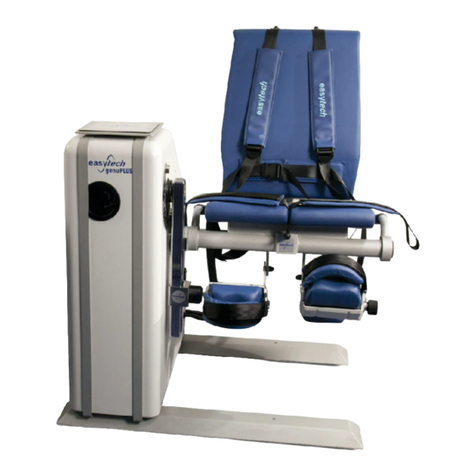
Easytech s.r.l. –T CaRe Compact User’s Manual rev. D Pag. 3 di 36
INDEX
1. INTRODUCTION ....................................................................................................................... 4
1.1 T CaRe Compact intended use ........................................................................................ 4
1.2 Applied standards ............................................................................................................ 4
2. PRESCRIPTIONS FOR SAFETY ............................................................................................. 6
2.1 Easytech responsibilities ............................................................................................... 6
2.2 Warnings concerning installation, maintenance and regular inspections ......... 6
2.3 Precautions for use ......................................................................................................... 7
2.4 Warnings regarding electromagnetic interference .................................................. 8
2.5 EMC tables......................................................................................................................... 8
2.6 Special prescriptions for the operator ..................................................................... 13
2.7 Special prescriptions for the patient ........................................................................ 13
2.7.1 Contraindications ....................................................................................................... 13
2.7.2 Particular caution ................................................................................................... 14
2.8 Safety devices ................................................................................................................ 14
3. DESCRIPTION OF THE DEVICE ........................................................................................... 15
3.1 Control Unit ..................................................................................................................... 15
3.2 Electrodes ........................................................................................................................ 16
3.3 Sales Configuration ....................................................................................................... 19
3.4 T CaRe Compact Technical Characteristics ............................................................ 20
4. USING T CARE COMPACT ................................................................................................... 21
4.1 Knob for power adjust .................................................................................................. 21
4.2 Operations with user interface ................................................................................... 21
4.3 Treatment ........................................................................................................................ 22
4.4 Manual Settings .............................................................................................................. 22
4.5 Set-up commands ........................................................................................................ 25
5. GUIDELINES FOR TREATMENT WITH T CARE PLUS .................................................. 26
5.1 Preparing the treatment............................................................................................... 26
5.2 Placing the patient ......................................................................................................... 26
5.3 How to place the Electrodes ...................................................................................... 26
5.4 Operating in Resistive Mode ........................................................................................ 27
5.4.1 Using of Manual Treatment Kit (TMA Kit – Optional) ........................................ 27
5.5 Operating in Capacitive Mode ..................................................................................... 28
5.6 Checks to be performed during the treatment ..................................................... 28
6. MALFUNCTIONS .................................................................................................................... 29
7. MAINTENANCE ....................................................................................................................... 30
7.1 Cleaning the exterior ..................................................................................................... 30
7.2 Periodic inspection and life cycle of the unit ......................................................... 30
7.3 Calibration and settings (by the Easytech Technical Service) .......................... 31
7.4 Fuses replacement ........................................................................................................ 31
8. TRANSPORT ............................................................................................................................ 32
8.1. Environmental and condition for transportation and storage ........................... 32
8.2. Packaging ......................................................................................................................... 32
9. UNIT DISPOSAL AT THE END OF ITS LIFECYCLE ....................................................... 32
10. LABELS ................................................................................................................................ 33




























